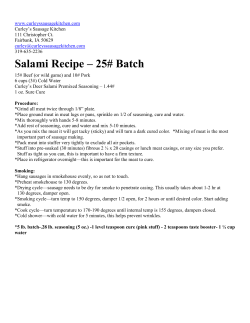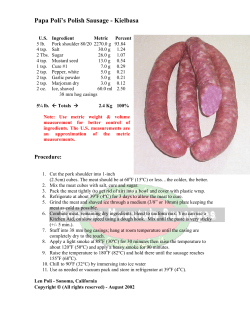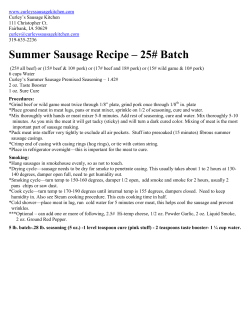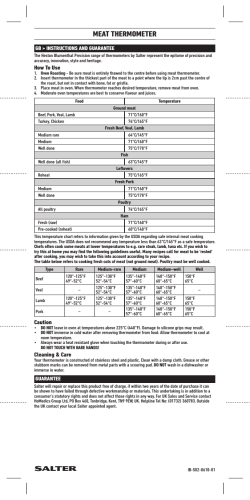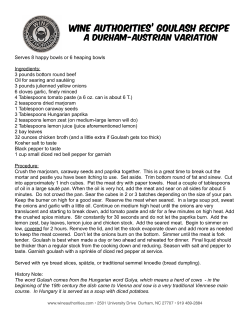
Document 356062
National Meat Workshopp Legislation: Meat and Meat Products Trade and Marketing Dr. Kerapetse Sehularo Department of Veterinary Services (Botswana) 17 – 18 November, NFTRC, Kanye Presentation outline i. ii ii. iii. iv. v. vi. vii vii. viii. Introduction Le islati e Frame Legislative Framework rk Legislative Framework: Principles and Objectives Current Situation Challenges g Action Taken and Proposed Solutions Recommendations Conclusion i. Introduction a. GDP – Agriculture 3% after mining and tourism industry, Livestock sector 80% of Agriculture GDP. b. Livestock industry is the mainstay of the rural economy. c. LLivestockk population l – 2.5 2 5 million ll cattle, l 580 000 goats, 160 000 sheep, h 4 300 pigs and self sufficient in poultry products. d. Botswana – a meat consuming nation. e. Botswana has successfullyy maintained access to the stringent g and lucrative Norwegian and EU markets. f. A large proportion of meat consumed domestically is uninspected – the situation improving since implementation of the Livestock and Meat Industries Act, 2007 in 2008. ii. Legislative Framework a. Shared responsibilities between different government agencies b. Livestock and Meat Industries Act, 2007 (Primary Legislation) – MoA c. Diseases of Animal Act, 1977 – MoA d d. F d Control Food C t l Act, A t 1993 – MoH M H andd MoLG. M LG e. Public Health Act, 1971 (under review) – MoH and MoLG f.f Local government (District Council) Act Act, 1965 – MoLG g. Townships Act, 1955 – MoLG h. Trade Act – MoLG i. European Union Food Law - MoA j. RSA Meat Safety Act (Act No. 40 of 2000) – MoA k. Other Trading Partners requirements - MoA iii. Legislative Framework – Principles and Objectives a. FBO – responsible for the safety of the meat and meat products. b. Regulatory and Competent authorities responsible for the enforcement and verification of compliance with the requirements. c. Meat safety – food production continuum. d. Cold chain maintenance. e. HACCP system and related procedures, GHP are paramount to meat safety assurance. f. Livestock and product traceability system. g. WTO Obligations Obli i – CAC/RCP 1-1969, 1 1969 R Rev, 4-2003). 4 2003) The overall objective of any food safety legislation is the protection of the health of consumers. iv. Current Situation a. Livestock and Meat Industries Act, 2007 ((Primaryy Legislation). g ) History - Prior to the Re-Enactment of the Act, fragmentation. ¾ Slaughter - of domestic livestock, farmed and wild game and poultry for human consumption, the control and operation of abattoirs, slaughter slabs, cold storage facilities, meat processing plants, cutting premises, canning plants and marketing, grading and inspection of livestock, livestock products and other related matters. ¾ No person shall operate an abattoir unless registered with DVS. ¾ Registration and Licensing, enforcement and verification of compliance with requirements by DVS. ¾ Penalties for operating unregistered abattoir – P6 000.00 or max. 3 months imprisonment or both or imprisonment without option of the fine, continuous offence, a max. of P2000.00, for every day during which the offence continues. ¾ Penalties for contravening the provisions of the Regulations – P1000.00 or imprisonment max. 3 months, P500.00 each day continuing offence, P2000.00 or max. 6 months for a second or subsequent offence, cancellation or suspension of the license on conviction. iv. Current Situation cont.... ¾ Scope – Primary production to meat dispatch. ¾ Diseases of Animals Act, 1977 – SRM and Traceability system ¾ Trading partners requirements. b. Meat Safety f y System: y ¾ Animal movement permit system – Ante-Mortem ¾ P h lth check Pre-health h k att abattoirs. b tt i ¾ Ante- and post-mortem inspections. ¾ Cold chain maintenance. ¾ Hygiene monitoring. ¾ Product testing and residue monitoring. ¾ Verification of compliance – requirements, requirements HACCP and its related procedures. ¾ Product certification. iv. Current Situation cont.... c. ¾ Infrastructure: Licensed red meat premises Abattoirs Slabs Municipal Export Comments 13 9 3 Most municipal abattoirs are in the Central District Council ¾ 46 Poultry Premises Total 22 ¾ Cat. D2 4 Cat. D1 1 Cat. C 9 Cat. B Cat. A 6 2 Laboratory: Two main laboratories – National Veterinary Laboratory and Food Control Unit Laboratory d. Meat Inspectorate Personnel – Headed by a Deputy Director of Veterinary Services ¾ 9 Veterinarians and ¾ 94 Meat inspectors (43 at non-export establishments) v. Challenges a. Success at export establishments, in particular BMC. b. Challenges at non non-export export meat establishments. ¾ Almost all non-compliant. ¾ Many slaughter slabs – inspection service delivery constrained. ¾ Inadequate investment to assure meat safety. ¾ Inadequate q meat inspectorate p staff. ¾ Inadequate transport. ¾ Untrained and unskilled personnel at meat premises. ¾ O l i llegislation. Overlapping i l ti ¾ Legislation not in line with international standards. ¾ Fragmented food safety control system vi. Action taken and Proposed solutions a. Rationalisation of personnel and responsibilities at export abattoirs. b. Temporary licensing of existing meat estalishments. c. Training of more meat inspectors and extension agents. d. Provision of mobile meat inspection service. e. Consultative workshops. p f. Private investment. g. More municipal abattoirs in areas where it is not economically viable for pprivate investors. h. Collaboration with village development authorities - provision of proper slaughter slabs. i.i Review of the meat safety legislation in line with international standards. standards j. Harmonisation of the meat safety legislation. k. Adoption of an integrated approach to meat safety – food production continuum. continuum l. Adoption of HACCP system and its related procedure. vii. Recommendations a. Formulation and implementation of a national food safety policy. b. Development of a harmonised food safety management system. a. Coordinated food safety management responsibilities or a development of a single food safety authority. a. Integrated multidisciplinary approach to food safety management through the concept of food production continuum. viii. Conclusion a. Safe, wholesome and unadulterated meat and meat products – consumer’s right. b. Integrated multidisciplinary approach – will improve food safety. c. Development and implementation of food safety policy supported by a prerequisite i i ffor efficient ffi i and d effective ff i ffood d safety f management system supported by necessary legislative framework, controls, procedures, facilities, equipment, laboratories, transportation, communication, personnel and training. g d. FBO responsible for the safety of the product. e. Regulatory agency responsible for enforcement of legislation and verification of compliance. f. Stakeholder participation in the implementation of the Livestock and Meat Industries Act, 2007 will go a long way in achieving meat and meat product safety. Ke a leboga Thank you y Factors affecting the production and marketing of poultry and other white meat products in Botswana. Factors that affect the production of white meat start from a reliable source of the day old chick, the day old must be healthy and vigorous at receipt. It should be a minimum of 40 grams at hatching, the egg from which the day old is hatched should have come from a parent stock that has been adequately vaccinated to ensure that the chick has sufficient maternal antibody to protect it from the two major diseases which are endemic in Botswana namely Gumboro and Newcastle diseases. The parents stock must as well be free of Mycoplasma. The day old chick must be housed in suitable housing protecting it from the elements, rain, wind, sun and be given sufficient floor space to enable it to move freely to water and feed. Temperature needs to be controlled as day old cannot regulate their own temperature until Feed which is the major cost in broiler production must be freely available and fed ad lib throughout the life of the bird. The feed quality must be such that the bird will grow according to the breed standard and convert the feed to meat at the correct feed conversion rate, hence the first requirement of the feed is that it be palatable and contain all required amino acids, vitamins and minerals in the correct proportions to enable the bird to grow to it, full potential. Feed must be salmonella free. Water is as equally important as feed and again must be freely available at all times. Water quality like the feed must be of a good quality, to ensure that the birds will readily drink, water containing a high concentration of salt, or be tainted will reduce the water intake, if the water intake is reduced the feed intake is also reduced. On average a bird will drink twice the volume of water to feed (2 to 1). During the life of the bird it must be vaccinated on order to protect it from the chicken disease prevalent in Botswana, these vaccines are sensitive to misuse and unless administered correctly will not give the birds the necessary protection. We continue to raise the bird by monitoring it environment ( protection from wind , providing heating where necessary and ensuring the bird id raised on suitable bedding). At approximately 35 days of age, the bird should weigh approx 1.7 kilogram and is ready to be slaughtered. The live birds are examined by the Meat Inspector prior to it going to the plant for processing. The bird is caught and transported with due care and attention that it arrives at the abattoir plant in the best possible condition to be slaughtered, the birds must arrive alive and not be bruised by the catching team or any handler prior to being bled. All bruised meat is automatically condemned. On arrival at the plant the live birds are examined by a Meat inspector and if passed as healthy, are passed through a stunner (which renders it unconscious) after which the stunned bird has its throat cut and allowed to bleed to death. The removal of the feathers is done by first scalding the carcass and the using a plucking machine, after which the body cavity is, opened the and the guts etc removed, all edible offal’s are retrieved and the none edible parts discarded. The eviscerate is again inspected by the meat inspector at this point especially the liver for any sign of disease , if the carcass is found unsuitable it will be condemned in full or in part. Note all condemned meat must be destroyed in a manner that ensures that it cannot enter the food chain (NOT AVAILABLE FOR HUMAN CONSUMPTION.) The carcass is ready to be further processed or not, it may simply be packaged as a whole bird or cut into pieces to create portions i.e. drum stick, wings, breast, thighs, or packaged as a 2 kg INDIVIDUALLY QUICK FROZEN product. The cut packaged product is put into refrigeration as soon as possible usually and minus 25 degree Celsius, and frozen Except some products are supplied and delivered to the shops as a ‘fresh’ product. I.e. has not been frozen only chilled to approx 0 degree centigrade prior to despatch The goods are transported in refrigerated or covered trucks and if transported over 100 kilometres, the truck must be fitted with a refrigeration unit in order to maintain the cold chain. The slaughter process is subject to the conditions as set out in the “MEAT INDUSTRIES ACT” and supervised by the Meat INSPECTORS APPOINTED BY THE Ministry of Agriculture, who monitor all aspects of the process including the health status of the staff, their protective clothing and the sanitary arrangements in the showers and toilets. The plant is kept very clean! That will ensure that the product sold does not have a high bacteria count (e.coli or salmonella) which may cause illness to the consumer. The product must confirm in every way to the packaging and labelling regulation, the packaging must indicate the sell by date. Marketing of the finished product. Marketing of the product is difficult and takes a lot of time, but the first requirement is a clean well packaged product, that is available continually. Once having gotten a customer it is imperative that you keep him whilst you whilst you go out and find another. Regrettably small producers usually find it very difficult to break in to the bigger markets such as Choppies and Spar, because of quality, price and continuity of supply. PRESENTATION PAPER – NATIONAL MEAT WORKSHOP FACTORS AFFECTING PRODUCTION AND MARKETING OF PIGGERY PRODUCTS IN BOTSWANA – FARMERS PERSPECTIVE PREPARED BY: BY SIMON MAHOSI (SECRETARY: BOTSWANA PORK PRODUCERS ASSOCIATION) E E-mail il address: dd [email protected] i h i@ h Mobile: 72474730 1 FACTORS AFFECTING THE PRODUCTION AND MARKETING OF PIGGERY PRODUCTS IN BOTSWANA – FARMERS PERSPECTIVE” INTRODUCTION INTRODUCTION Piggery has been defined by many researchers as an industry in an infancy stage, characterised by the following peculiarities: 1. Unorganised and fragmented producers/farmers 2. Low local production volumes Low local production volumes– imports reliant imports reliant 3. Using traditional methods of production and technologies 4. Insignificant contribution to: a) The agricultural sector b) The national economy c)) Employment creation E l t ti 2 FACTORS AFFECTING PRODUCTION An analysis of the factors affecting production in the piggery subsector will be done against the background of the subsector characteristics listed in the introduction above. In an attempt to further assist the understanding of the problems encountered in In an attempt to further assist the understanding of the problems encountered in piggery, we will categorise the problem fields under the following headings: a) Subsector Internal factors, b) Support systems factors and c)) E lF External Factors 3 SUBSECTOR INTERNAL FACTORS 1 U 1. Unorganised farmers i d f a) No norms, no regulations b) No transparency ‐ exploitation y y c)) Everybody for himself d) Dog eat dog situation e) No communication 2 Low local production Volumes 2. a) Operating below BEP (farms going bust) b) Quality compromised c) Inability to meet supply obligations 3. Outdated, traditional production methods and technologies a) Further drop in production levels b) Inability to meet quality standards Inability to meet quality standards c) Relegated to subsistence farming 4 SUBSECTOR INTERNAL FACTORS Continued 4. Insignificant contribution to the agricultural sector, the economy and employment creation a) Not qualify for programs supporting other subsectors b) Have no voice even on issues that concern the subsector c)) L Loose personnel to other subsectors l h b 5 SUPPORT SYSTEMS 1. No organised stakeholders forum a)) U f i t di Unfair trading practices ti b) Counter productive decisions/programs c)) Subsector critical issues overlooked 6 SUBSECTOR EXTERNAL FACTORS 1. Lack of developed Infrastructure a) No Water Supply (except in Kgatleng) b) No abattoirs No abattoirs c) No programmed (coordinated) Technical support 2. Lack of Essential Inputs a) Main feed ingredient (yellow maize) imported b) Subsidized Medication “Stolen” by retailers b d d d “ l ”b l c) Prohibitive permit requirements on feed imports d) Locally available feed expensive e) Subsector feed not available at LACs f) Acutely Limited genetic pool g) Prohibitive permit requirements on livestock imports 7 FACTORS AFFECTING MARKETING As with production inhibiting factors, it is also important to view the factors affecting the marketing of pork products in our country in the context of the nature, size and location of the market in which such products are to be sold size and location of the market in which such products are to be sold. FACTORS EMANATING FROM THE NATURE OF THE MARKET The market for pork products is composed of: a) Pork products Processors, a) Hypermarkets, b) Butcheries, c) Restaurants and d) Hotels. 8 FACTORS AFFECTING MARKETING FACTORS EMANATING FROM THE NATURE OF THE MARKET (Continued) Most Hypermarkets are chain stores than belong to one company, so although the outlets can be 15,, in reality y y you have 3 companies p operating p g those 15 stores. Another fact is that almost all these chain stores are foreign companies and are run by foreign managers. This scenario portrays an unorganised market with a few players controlling large volumes of orders orders. It is indeed a very sensitive and fragile 9 Market features which tend to inhibit the marketing of locally produced piggery subsector products: 1. Preference of imports over locally produced products by managers p yp p y g 2. Impossible demands on supply terms 3. Exploitative trading practices: a) different price rates for different farmers b) late payment (14 – 60 days) c) 3% deduction for fresh carcasses 3% deduction for fresh carcasses d) Carcasses without heads if bought from “A”; with heads if bought from “B”. 10 Market features which inhibit the marketing of locally produced piggery subsector products: 1. The status quo benefits from chaos and does not support supply contracts programs. 2. Government support programs such as “The Youth Grand” bring into the industry, farmers who can sell at any price and then close shop as they have nothing to loose nothing to loose. 3. Disease outbreaks such “food and mouth” and swine flu were used as an excuse to cut the price paid to farmers 11 Market Size related factors that inhibit the marketing of locally produced piggery subsector products: 1. Although statistics reveal a large, undersupplied market, decisions by one or two distributors can have an enormous contraction effect on the market ; as it is concentrated in the hands of a few distributors. (Desperate farmers dump their products for peanuts) 2. Demand for special cuts and certain pork products is very high and distributors seem to have reserved this market niche for foreign suppliers. (Individual farmers are not able to supply huge volumes needed for the production of these cuts/products) 12 Location Factors: 1. Long distances from (>50km) from the market 2 2. Long distances from (>50km) from the source of inputs Long distances from (>50km) from the source of inputs 3. In close proximity to a competing world class giant (South Africa) 4. Location with no readily available skilled manpower 5. Where markets are influenced by religious beliefs (Halaal) 6. Potential markets in far away places like Ghanzi and Maun too far to service. 13 CONCLUSION In conclusion, we would like to make recommendations to the following stakeholders: a) Government, b) Distributors c) Farmers 14 RECOMMENDATIONS TO GOVERNMENT 1. Assist the industry with the construction of an abattoir that will also function as the central market for pork products. products 2. LAC’s should stock feed and medication for the piggery subsector. 3. The breeding Centre in Sebele should liaise with Botswana Pork Producers Association to find better ways of distributing the breeding stock to the farmers. The current auctioning system is counter productive. 4. The mentoring aspect should be central to the Youth Fund Program to ensure projects’ success and sustainability. Currently the projects collapse as soon as the funds dry dry‐up up after the youngsters have dumped their products into the market at ridiculously prices. This practice is killing the market. 5. Veterinarian officers in the districts should have a clear schedule of how and when they assist farmers in their regions and not just to go to the farmers to collect statistics about the livestock. 15 RECOMMENDATIONS TO DISTRIBUTORS 1. Distributors should be part of joint stakeholders forum composed of farmers, distributors and government, which should set binding ethics, rules and regulations for the subsector. subsector 2. Distributors should give farmers a fair price for their products. 3. Distributors should share the costs of slaughtering and distribution of pork carcasses from the abattoir to their premises (Senn Foods has proofed that this can work). 4. Distributors b should h ld pay farmers f within h the h shortest h possible bl time (Senn ( Foods d is successfully paying farmers with cash cheques). 16 RECOMMENDATIONS TO FARMERS 1. Farmers should organise themselves into AMA’s at the regional and these (AMA’s) (AMA s) should draw up:‐ should draw up: a) Joint production plans b) Joint inputs procurement plans c) Joint marketing plans and d) Joint personnel and technologies development programs 2. The farmers should form district associations to coordinate the regional AMA’s. 3. The national association, “Botswana Pork Producers Association” should coordinate the district associations to reinforce strategies drawn up at the farms by the farmers. The current Top to bottom approach has been the cause of failures of all the previous BPPA executive committees 17
© Copyright 2024
